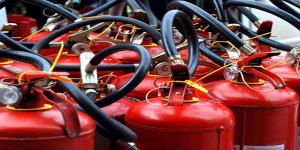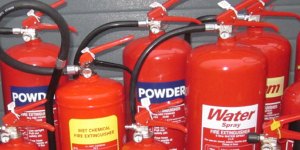|
|
Fire Extinguisher
|
|
A fire extinguisher is an absolute necessity in any home or office. While there's
a good chance that the extinguisher will sit on the wall for years, collecting dust,
it could end up saving your property and even your life. Having a fire extinguisher
at home or at the office is a necessity as one does not know when there may be a
raging fire that will endanger the lives of the people within the vicinity. Apart
from knowing how exactly to use a fire extinguisher, one also needs to possess basic
knowledge about type of fire extinguisher and its color markings.
|
|

|
|
Fire extinguisher colors are basically small markings on the red body of a standard
fire extinguisher that help distinguish their different types. There are many different
kinds of fire extinguishers available in the market each having its own purpose.
They contain varied constituents and are suitable for putting out only particular
kinds of fires. For example, there is a different fire extinguisher for putting
out fires caused due to short circuiting and different ones caused due to gas leakage.
The components of each extinguisher are combined in such a way to be appropriate
for certain kinds of fires only.
The kind of fire extinguisher color that is being chosen depends mainly on the probability
of a certain kind of fire in the area where one needs to install it. For example,
at a factory with a lot of under wiring, there may be a risk for short circuits.
On the other hand, at a chemical manufacturing unit, there may be risk of chemical
based fires that require different components to fight the fire with.
There are diverse fire extinguisher color codes for different nations and continents.
There is no uniform fire extinguisher color guide that can be consulted by everyone
across the globe. The colors of fire extinguishers are basically based on local
areas. However, color coding standard is followed by most manufacturers to make
it easier for the customers to identify what they need.
Types of Extinguishers
Water is the most familiar extinguishing material, and it is one of the most effective.
But it can be dangerous in the wrong situation. A water extinguisher can
put out things like burning wood, paper or cardboard, but it does not work well
on electrical fires or fires involving inflammable liquids. In an electrical fire,
the water may conduct the current, which can electrocute you. Water will only spread
out an inflammable liquid, which will most likely make the fire worse.
One popular extinguisher material is pure carbon dioxide. In a carbon dioxide
extinguisher, the carbon dioxide is kept in pressurized liquid form in the cylinder.
When the container is opened, the carbon dioxide expands to form a gas in the atmosphere.
Carbon dioxide gas is heavier than oxygen, so it displaces the oxygen surrounding
the burning fuel. This sort of fire extinguisher is common in restaurants because
it won't contaminate the cooking equipment or food.
The most popular extinguisher material is dry chemical foam or powder, typically
made of sodium bicarbonate (normal baking soda), potassium bicarbonate (nearly identical
to baking soda), or monoammonium phosphate. Baking soda starts to decompose at only
158 degrees Fahrenheit (70 degrees Celsius), and when it decomposes, it releases
carbon dioxide. The carbon dioxide, along with the insulation of the foam, works
to smother the fire.
Most fire extinguishers contain a fairly small amount of fire-suppressant material
-- you can use it all up in a matter of seconds. For this reason, extinguishers
are only effective on relatively small, contained fires. To put out a larger fire,
you need much bigger equipment -- a fire engine, for example -- and the professionals
who know how to use it. But for the dangerous flames that can pop up, a fire extinguisher
is an invaluable lifesaver.
|
Fire Extinguisher
|
|
Fire is the result of a chemical combustion reaction, typically a reaction between
oxygen in the atmosphere and some sort of fuel (wood or gasoline, for example).
Of course, wood and gasoline don't spontaneously catch on fire just because they're
surrounded by oxygen. For the combustion reaction to take place, the fuel has to
be heated to its ignition temperature. As you can see, there are three essential
elements involved in this process:
|
|

|
|
- Extreme heat
- Oxygen (or similar gas)
- Oxygen (or similar gas)
Fire extinguishers are designed to remove at least one of these elements so that
a fire will die out.
Inside an Extinguisher
To put a fire out, you need to effectively remove one of elements (Extreme heat,
Oxygen (or similar gas), Fuel)
The best way to remove heat is to dump water on the fire. This cools the
fuel to below the ignition point, interrupting the combustion cycle.
- To remove oxygen, you can smother the fire so it is not exposed to
air. One way to smother a small fire is to cover it with a heavy blanket. Another
way is to dump nonflammable material, such as sand or baking soda on top of it.
- Removing the fuel is the most difficult approach for most fires. In a house
fire, for example, the house itself is potential fuel. The fuel will only be removed
once the fire has burned all of it up.
Fire extinguishers are sturdy metal cylinders filled with water or a smothering
material. When you depress a lever at the top of the cylinder, the material is expelled
by high pressure, similar to the way material is forced out of an aerosol can.
Maintenance of an Extinguisher
- Maintenance Inspection:
All types of extinguishers should be inspected at least once a year. The extinguisher
is checked to make sure it has proper pressure (gauge in green or proper cartridge
weight), has the correct volume of extinguishing agent (tech weighs it), is within
the required hydrotest and internal maintenance intervals, is in good condition
and all external parts are serviceable. Often, dry chemical and dry powder types
are hit on the bottom with a rubber mallet to make sure the powder is free-flowing,
which is called "fluffing" the powder. The tech will then attach a new tamper seal
around the pin and a yearly service tag.
- Internal Maintenance:
- Water - every 5 years Foam - every 5 years
- Wet chemical & CO2 - every 5 years
- Dry chemical - every 6 years
- Halon and clean agents - every 5 years.
The extinguisher is emptied of its chemical and pressure to check for proper operation.
All components are disassembled, inspected, cleaned, lubricated, or replaced if
defective. Liquid agents are replaced at this time, dry agents may be re-used if
in good condition, halon is recovered and re-used, but CO2 is discharged into the
atmosphere. The extinguisher is then re- filled and recharged, after a "verification
of service" collar is placed around the cylinder neck. It is impossible to properly
install or remove a collar without depressurizing the extinguisher. Note: Cartridge-operated
extinguishers should be visually examined, but do not require a verification of
service collar.
- Hydrostatic testing:
- Water, Foam, Wet chemical, and CO2, every 5 years.
- Dry chemical, dry powder, halon, and clean agents, every 12 years.
Note: these are the required intervals for normal service conditions, if the extinguisher
has been exposed to excessive heat, vibration, or mechanical damage it may need
to be tested sooner.
The agent is emptied and depressurized and the valve is removed. After a thorough
internal and external visual inspection, the cylinder is filled with water, placed
inside a safety cage, and pressurized to the specified test pressure (varies with
the type, age, and cylinder material) for the specified time period. If no failure,
bulges, or leaks are detected, the cylinder passes. The cylinder is then emptied
of water and thoroughly dried. CO2 types have the test date, company's ID, etc.
stamped on the cylinder, all other types get a sticker on the back of the cylinder.
Once dry, the units are recharged. Unlike the UK, the US does not rebuild extinguishers
and replace valves at specific intervals unless parts are found to be defective,
with the exception of halon. Halon types are often given new o-rings and valve stems
at every internal maintenance to minimize any leakage potential.
|
|

|